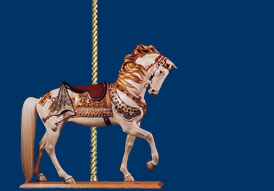STRIPPING
PROCESS
It
should be noted that even as unglamorous as the stripping process
can be, it is a very important step in the restoration process.
Great care must be taken not to damage the carving. The stripping
process can be a messy, tedious, laborious job. Although, what
is sometimes discovered beneath years of paint can be quite
exciting. In this case the paint on the cover
horse hides most of the very intricate detail on the trappings.
At some point in time the horse had been stripped and the original
paint lost. However, as the saddle area is stripped, we find
very ornate leafing and flower designs within the obvious elaborate
scroll work. A strap on the rump yields a face with a ring through
its mouth. The mane is much more intricate and deeply carved
than it appeared and flows down the back of the neck. The lumps
and bumps on the thighs are veins.
Stripping
begins with a variable temperature heat gun. Excessive heat
can burn the wood and even loosen glue joints. Once the paint
is removed using the heat gun and a round edged putty knife,
which prevents accidental digging into the wood, the details
are finished using a chemical stripper and a light touch with
a brass wire brush until clean.
<
1
2
3 4
5 > Next

